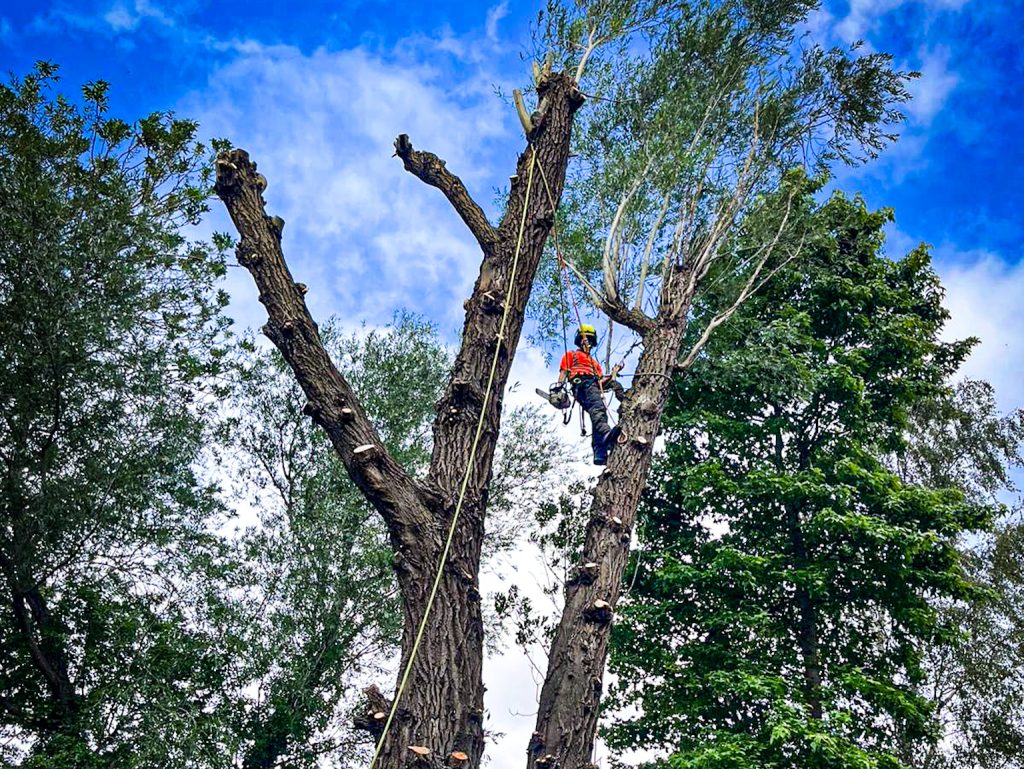
Case Study No.15: It finally dried out, About Trees can get to work. Tree management along The Stour in Kent
Introduction
About Trees Ltd, a full-service arboricultural company, recently undertook a domestic tree management project along the Great Stour. This picturesque area in Southeast England boasts diverse flora that require regular maintenance to ensure their health, safety, and contribution to the landscape. This case study examines the specific tree management and maintenance activities carried out by About Trees Ltd along the Great Stour, detailing the species involved and the tasks completed.
Objectives
The primary objectives of the tree management project were:
1. To maintain the health and safety of the privately owned trees along the Great Stour.
2. To enhance the visual appeal of the area by managing tree growth and structure.
3. To ensure the safety of the public and property by removing hazardous trees or branches.
4. To use the wood from felled trees in an environmentally friendly manner.
Tree Management Activities
The project involved the following key activities:
1. Prunus avium (Wild Cherry)
– Location: Just over the footbridge on the right-hand side, on the edge of a newly cleared section.
– Action: A multi-stemmed tree was felled to ground level as it was unsafe. The wood was stacked along the bar and rail fence marking the boundary.
– Dead Stem: Another wild cherry tree, previously damaged by a falling cedar during storms, was cut down to ground level to prevent decay and potential danger.
2. Salix fragilis (Crack Willow)
– Location: On the river bank, near an Acer whip and Prunus.
– Action: A small crack willow was felled to ground level to manage its growth and maintain the area’s ecological balance.
3. Liquidambar styraciflua (Sweet Gum)
– Location: On the same bank, near a stand of cherry trees.
– Action: A gnarled sweet gum tree had a dead branch growing over the river, which was removed to prevent potential accidents.
4. Salix babylonica (Weeping Willow)
– Location: Near the neighbour’s bridge.
– Action: A large, previously pollarded weeping willow was re-pollarded back to previous points at 8-9 metres above ground level, removing 6-8 metres of growth from the branch tips. The wood was stacked near the tree for ecological benefits.
5. Salix fragilis (Crack Willow)
– Location: Near the mooring spot for the rowboat.
– Action: Another mature crack willow was re-pollarded back to previous points, with all adventitious growth cleared from the stems. The wood was stacked near the weeping willow.
6. Tilia cordata (Small-Leaved Lime)
– Location: On the field side western boundary near the small brick bridge.
– Action: The tree was pruned to open up the view, reducing the identified branch by 4 metres to a suitable upright growth point, enhancing the landscape’s aesthetic appeal.
7. Acer negundo (Box Elder)
– Location: On the field side western boundary near the small brick bridge.
– Action: A smaller, secondary branch over the pond was removed to improve the vista.
Challenges and Considerations
– Access: Access to the neighbour’s garden was required for processing brushwood and winching across the river. Ground conditions significantly influenced the ability to get vehicles close to the work area. Given that the two large willow trees were surrounded by ponds, the river, and its tributaries, timing was critical. The project had been in planning since September 2023, but actual work could only commence when the ground conditions were sufficiently dry. This delay ensured minimal damage to the surrounding area and enabled the safe use of heavy machinery.
– Environmental Impact: The area is prone to water-logging, necessitating careful movement to minimise damage to the ground. Working in such conditions required the use of specialised off-road vehicles capable of navigating the soft and potentially unstable terrain without causing excessive harm.
– Safety: Ensuring the safety of the workers and the public was paramount, particularly when dealing with large trees and heavy branches. The strategic planning and careful timing of the project played a significant role in mitigating risks associated with the tree management activities.
Conclusion
The tree management project along the Great Stour was a comprehensive effort by About Trees Ltd to maintain the health, safety, and visual appeal of the area. By carefully selecting and executing specific actions for each tree, the project successfully balanced ecological considerations with aesthetic and safety requirements. The use of felled wood in an environmentally friendly manner further underscored the project’s commitment to sustainability.
Recommendations
– Regular Monitoring: Implement a routine monitoring schedule to identify and address potential tree hazards early.
– Neighbourly Engagement: Engage with local neighbours to inform and involve them in tree management activities, fostering a sense of stewardship.
– Sustainable Practices: Continue using sustainable practices for wood disposal and tree maintenance to enhance ecological benefits.
This case study highlights the expertise and meticulous planning of About Trees Ltd in executing tree management projects, ensuring the natural beauty and safety of the Great Stour are preserved for future generations.
